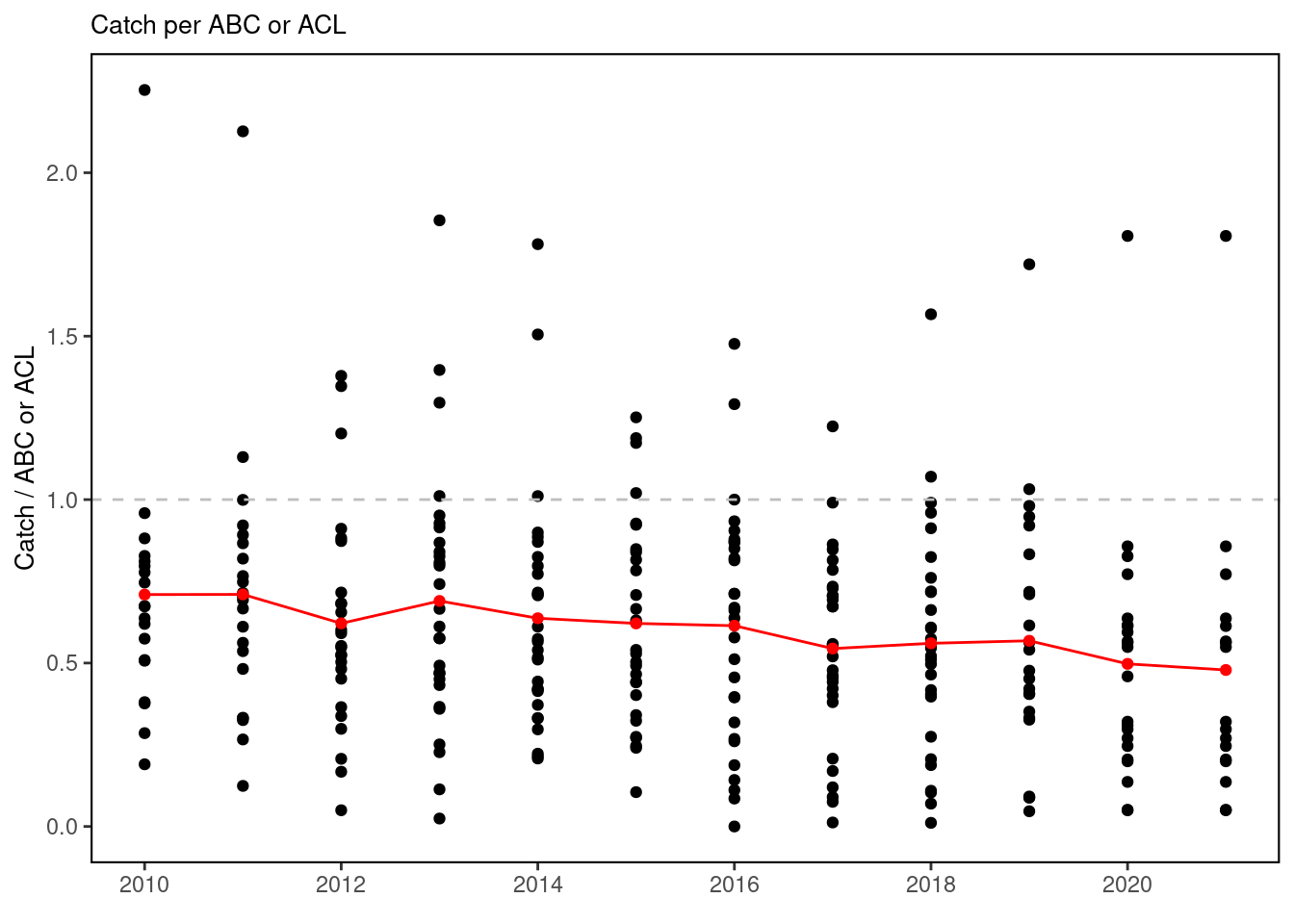70 ABC or ACL for Managed Stocks
Description: Mid-Atlantic Council catch limits (e.g., ABC or ACL) and associated total catch estimate by year for each species and sector (commercial or recreational, as appropriate).
Indicator family:
Contributor(s): Brandon Muffley, Jason, Didden, Julia Beaty, Jose Montanez, Karson Cisneros, Jessica Coakley, Hannah Hart, Kiley Dancy, Hayden Dubniczki
Affiliations: MAFMC
70.1 Introduction to Indicator
The ratio of total estimates catch (landings and dead discards) compared to the specified catch limit, either the Acceptable Biological Catch (ABC) or the Annual Catch Limit (ACL) by species and sector (e.g., commercial or recreational, if appropriate). This ratio can provide an understanding of management control to constrain total catch below the acceptable/specified limits through different management tools (e.g., trip limits, seasons, gear requirements etc.). Ratios above one can be an indicator of poor management control and/or uncertainties, or indicative that the catch limits in place are constraining on the fishery. Ratios below one could indicate greater management control and/or fewer uncertainties or that their may be other factors (e.g., markets, price, availability) may be limiting a sectors ability to reach its catch limits.
70.2 Key Results and Visualizations
Catch divided by ABC/ACL for MAFMC managed fisheries. Red line indicates the median ratio across all fisheries. A secondary figure is also produced that provides the sum of catch limits across all MAFMC managed commercial (C) and recreational (R) fisheries.
High points in the catch divided by ABC/ACL are recreational black sea bass (up to 2021) and scup (2022). No significant overages in 2023 were similar to the high ones in 2021 and 2022, but a number were slightly over in 2023 - recreational and commercial scup, recreational sea bass, recreational and commercial blueline tilefish, and spiny dogfish.
70.3 Indicator statistics
Spatial scale: Cape Hatteras, NC north to Maine
Temporal scale: Annual
Synthesis Theme:
70.4 Implications
Increasing/decreasing trends in the total ABC/ACL across all stocks can provide insights into potential changes to system productivity and fishing opportunities for Council managed species. While evaluating total estimated catch relative to the catch limit (ABC or ACL) can help provide insight into the degree of management control to constrain catch, limit overfishing, and identify potential underfishing situations (ie., not achieving the desired catch).
Since 2012, the total catch limits in the Mid-Atlantic have fluctuated slightly without any trend and the 2023 catch limit was similar to those set over the last four years. There is more variability at the species and sector level, but this suggests that overall stock abundance, productivity, and fishing opportunities have remained relatively stable within the Mid-Atlantic. Similarly, total estimated catch relative to the total catch limits in the Mid-Atlantic has fluctuated relatively little and without trend and has been below the total catch limit every year from 2012-2023 with a median of about 70 percent. This suggests that current catch limits are generally not constraining for most stocks and that there is some level of management control to ensure total catch remains below the catch limits to limit the risks of overfishing. In general, those fisheries where total catch exceeded the associated catch limit are associated with the recreational sector, particularly scup and black sea bass that have high biomass and availability.
70.5 Get the data
Point of contact: Brandon Muffley (bmuffley@mafmc.org)
ecodata name: ecodata::abc_acl
Variable definitions
Catch - definition: total landings and dead discards; units - metric tons (MT) Acceptable biological catch (ABC) - the annual catch level recommended for a stock or stock complex by the Scientific and Statistical Committee that could be equal to or less than the Overfishing Limit (OFL); units - metric tons (MT) Annual Catch Limit (ACL) - sector specific total catch limits which can be equal to or less than the ABC; units - metric tons (MT)
Indicator Category:
Indicator Category:
Management reports (e.g., specification packages, fishery information documents), stock assessment reports, or data pulls from CAMS
70.7 Accessibility and Constraints
No response
tech-doc link https://noaa-edab.github.io/tech-doc/abc_acl.html



